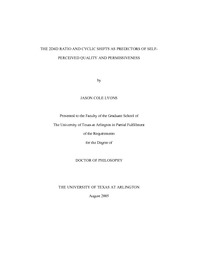
ATTENTION: The works hosted here are being migrated to a new repository that will consolidate resources, improve discoverability, and better show UTA's research impact on the global community. We will update authors as the migration progresses. Please see MavMatrix for more information.
Show simple item record
| dc.contributor.author | Lyons, Jason Cole | en_US |
| dc.date.accessioned | 2007-08-23T01:56:10Z | |
| dc.date.available | 2007-08-23T01:56:10Z | |
| dc.date.issued | 2007-08-23T01:56:10Z | |
| dc.date.submitted | July 2005 | en_US |
| dc.identifier.other | DISS-1036 | en_US |
| dc.identifier.uri | http://hdl.handle.net/10106/144 | |
| dc.description.abstract | The following paper discusses the findings from background research leading up to a discussion of findings from the present study. The relationships between female sexual permissiveness and female's self-perceived quality (SPQ) as a potential mate, male quality, and female age were evaluated. A woman's SPQ was predicted to correlate negatively with acceptance of sexual propositions but the data failed to support the prediction. It was further predicted that when male quality was relatively greater than female SPQ, the probability of accepting a casual sex proposition would be greater. Partial support for this prediction was found. Older females were more likely to accept sexual propositions than younger females, although this age difference decreased with increased male quality. The results of this study are discussed as well as some possible problems in methodology. The present study examines the previous relationships as predicted by variations in activational and developmental hormone levels as estimated by the 2D4D ratio by the participant's position in the menstrual cycle reported by the participants following revisions to the SPQ scale. Following this revision we expected to observe a negative correlation between the female participant's SPQ and the participant's scores of sexual permissiveness. This finding was supported. The scores of SPQ were predicted to be higher and scores of sexual permissiveness were predicted to be lower in women with high 2D4D ratios than in women with lower 2D4D ratios. After the removal of participants reporting sexual abstinence due to religious beliefs, current involvement in a relationship, and alcohol use, this relationship was observed. The relationship between SPQ and sexual permissiveness across the menstrual cycle was also examined. Relationships between sexual permissiveness and the menstrual cycle were not observed, but SPQ and the progression through the menstrual cycle showed a negative correlations. The possibility of SPQ serving as a mechanism for risk avoidance and other implications of these findings are discussed. | en_US |
| dc.description.sponsorship | Mellgren, Roger | en_US |
| dc.language.iso | EN | en_US |
| dc.publisher | Psychology | en_US |
| dc.title | The 2D4D Ratio And Cyclic Shifts As Predictors Of Self-perceived Quality And Permissiveness | en_US |
| dc.type | Ph.D. | en_US |
| dc.contributor.committeeChair | Mellgren, Roger | en_US |
| dc.degree.department | Psychology | en_US |
| dc.degree.discipline | Psychology | en_US |
| dc.degree.grantor | University of Texas at Arlington | en_US |
| dc.degree.level | doctoral | en_US |
| dc.degree.name | Ph.D. | en_US |
| dc.identifier.externalLink | https://www.uta.edu/ra/real/editprofile.php?onlyview=1&pid=155 | |
| dc.identifier.externalLinkDescription | Link to Research Profiles | |
Files in this item
- Name:
- umi-uta-1036.pdf
- Size:
- 373.7Kb
- Format:
- PDF
This item appears in the following Collection(s)
Show simple item record


